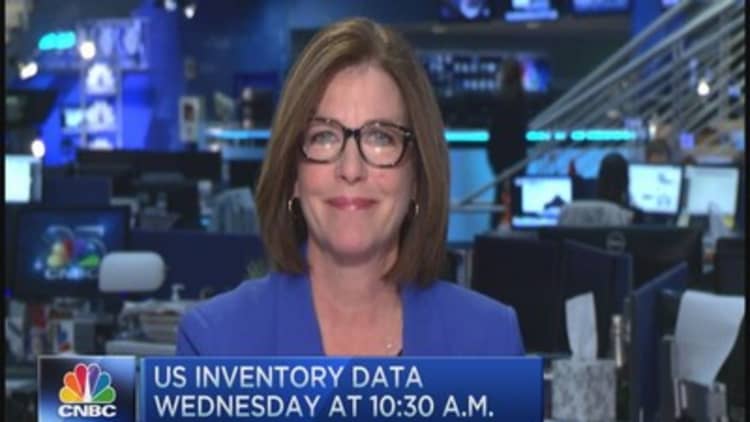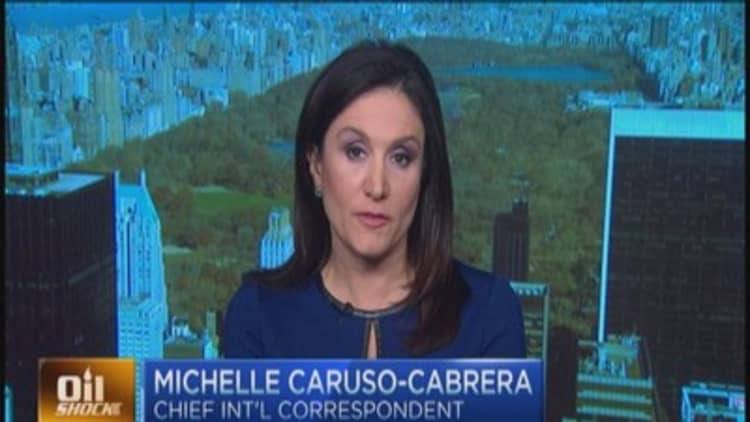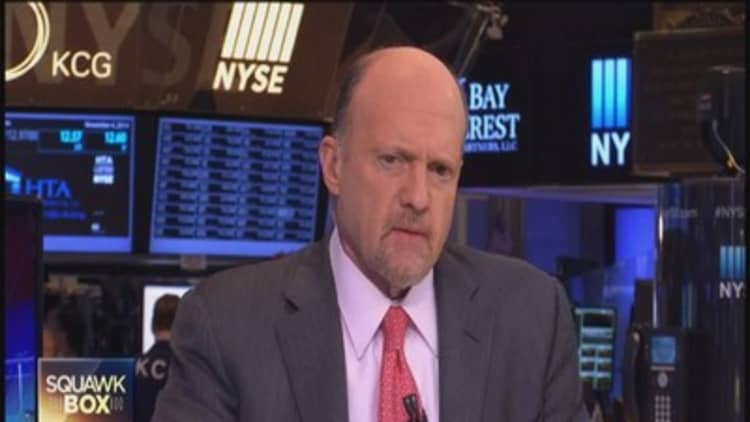
Oil prices could have a hard time finding a floor after Saudi Arabia trimmed prices in the face of growing North American oil production.
The market took the price cut this week as another sign the kingdom is willing to use pricing as a lever to preserve its market share, rather than cut production in what is now an oversupplied market. Even if it was not the intention, some traders took the Saudi move as a sign the kingdom would like falling prices to slow U.S. shale production.
U.S. West Texas Intermediate fell sharply on Tuesday, dipping close to the psychologically key $75-a-barrel level, before closing at a three-year low of $77.19, off $1.59 per barrel. Brent fell along with it to $82.82 a barrel, the lowest settle since October 2010, after Saudi Arabia set a new price in the U.S. 45 cents lower than November's level.
Tradition Energy analyst Gene McGillian said the next technical level he's watching for WTI is $74 a barrel, and it's not clear how much further it will fall.
"The managed money longs still outnumber shorts 3½-to-1. If this isn't a heavy exodus of the money manager longs, we could still have a significant drop, especially if all these factors that are driving us lower continue to weigh on the markets," he said. "The dollar strength and also fears of slowing economic conditions in Europe and China are still continuing to play a role."
Read MorePro: Energy investors should prepare for $60 oil
There was initially a muted reaction to the Saudi announcement Tuesday as the market focused on dollar strength and other factors.
"I don't think the probability is we're looking at a meltdown or collapse. If there was a global price war, it could go between $30 and $50 a barrel but more realistically, we're within 10 percent of the bottom," said Tom Kloza, senior oil analyst at Gasbuddy.com.
"What the Saudis are doing is business as usual. They change the price formula each month. The problem is there's an implication that it's business as usual in terms of production. The problem is if they continue to produce what they've been producing in the last two months, the market is headed for trouble, and downward pressure will be more significant than upward pressure," said Kloza.
Read MoreWhy cheap oil may not help the US as much anymore
Some analysts said the Saudis were motivated by market fundamentals. "In our view, it's not a direct attempt by Saudi Arabia to grab market share," said Dominic Haywood, crude and products analyst at Energy Aspects. "We think it's more a move by them to stimulate some demand from Gulf Coast refineries that are coming back from maintenance in November and December. By cutting to the U.S., you allow more exports to the U.S."
Haywood also did not think the Saudis were attempting to curb shale production. "In any case, you need crude below $70 a barrel for much longer than a month to limit U.S. production," he said.

Saudi Arabia's price setting was a market mover for a second month. For November, Saudi cut prices to Asian customers, and for December, it raised them for Asian and European customers while cutting U.S. prices. What the market sees as bearish is the lack of discussion of production cuts, analysts said.
"It's really the first time we are in this kind of era," said Max Denery, commodities strategist at Bank of America Merrill Lynch. "I think the OPEC meeting will be very interesting Nov. 27, and there is no real consensus about if they're going to cut or how much they're going to cut. They have a total ceiling of 30 million barrels. My thinking is if they cut between 300,000 and 500,000 barrels a day, it would not have an impact and might be bearish for the market because it's not enough to reduce the oversupply. If they cut 700,000 to 1 million, that would make a difference."
Denery said he sees the West Texas price stabilizing around $75 per barrel though it's possible the price could fall through that level first. He said prolonged prices of $70 would ultimately trigger a slowdown of production by some U.S. producers, and there could be less investment in new wells.
Read More
But he expects $75 to ultimately be the floor. "As soon as you see headlines about producers saying we need to cut some production or even close some wells, I think the market would react," he said.

The nature of the U.S. shale industry makes it flexible, serving as an economically driven swing producer that can brake or speed up production based on prices. Wells are most productive when they are first drilled, and production can be cut in half after the first year, so Denery said it is easier to slow production but not drilling new wells.
"We think that we need to have even lower prices to get some reaction from the shale industry. It's true that the supply response is much higher in shale than in other areas. In order to have significant reduction in growth, we would need to have WTI in the $70 area," Denery said.
Because U.S. breakeven costs for drilling vary dramatically by region and within regions, Denery said it would be the smaller producers with the highest costs that will be the first to slow down. "Those will be the first companies that will be hurt. Those companies do not hedge, and they try to produce as much as they can because they are on the edge," he said.
In the Permian Basin, in Texas and Oklahoma, companies' breakeven averages $55 to $60, while at Eagle Ford, they average $45 to $50, he said. In the Bakken in North Dakota, there is an area with $40 breakevens, but another area averages about $55 per barrel.
Watch: Read More
The levels can fluctuate within each area, and some of the higher-cost production could be as much as $70 or $75 a barrel.
Oppenheimer energy analyst Fadel Gheit said the type of oil companies most vulnerable to lower prices are those with the highest debt loads.
"Not one company so far admitted or denied that they are canceling projects, but the question is not how many producers will say they are canceling projects but the question is how many projects and which are the companies. Every company will slow down. The question is, is it 5 percent or 50 percent. It will depend on the financial flexibility and the nature of the investment," he said.
Denery has already projected growth in shale drilling will slow next year. "For this year, shale growth was about 1 million barrels. Next year, we believe a little less. From the combination of an efficiency gain and slightly lower prices, we think growth in shale will be about 700,000. If prices drop to $70 a barrel, then you might see a growth in shale of just 300,000 to 400,000 barrels a day," Denery said. "We're still going to get growth but there's going to be a reduction in growth."
Denery said demand has not yet responded to the lower prices, and he expects to see demand improve in 2015. "The demand reaction takes much longer than the U.S. shale supply elasticity. If we have a lower price in 2014 then you're going to see another maybe 300,000 barrels a day of growth," he said.
Weekly U.S. government data, due Wednesday, should show that the world is well supplied with crude and U.S. production continues to approach 9 million barrels a day, a million barrel a day more than last year. Oil inventory data is released Wednesday at 10:30 a.m. ET.
"We're looking for another big build in inventories, another 2 million plus barrels," said John Kilduff of Again Capital. "It's been massive in the last couple of weeks. It's really what flipped the term structure into contango." Contango is when futures for coming months show higher prices than the nearby prices, a bearish sign.
"I think these prices are going to remain under significant pressure into the OPEC meeting, and I think it's going to go very badly. It's going to set us up for another leg lower, possibly into the 50s in the first quarter," Kilduff said.



